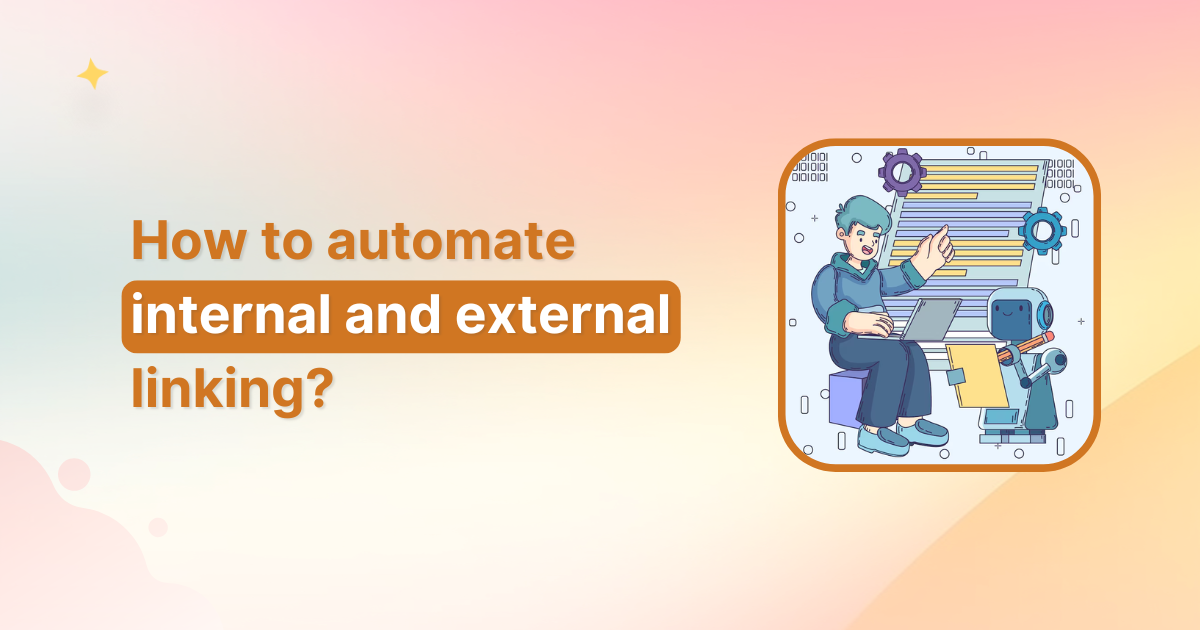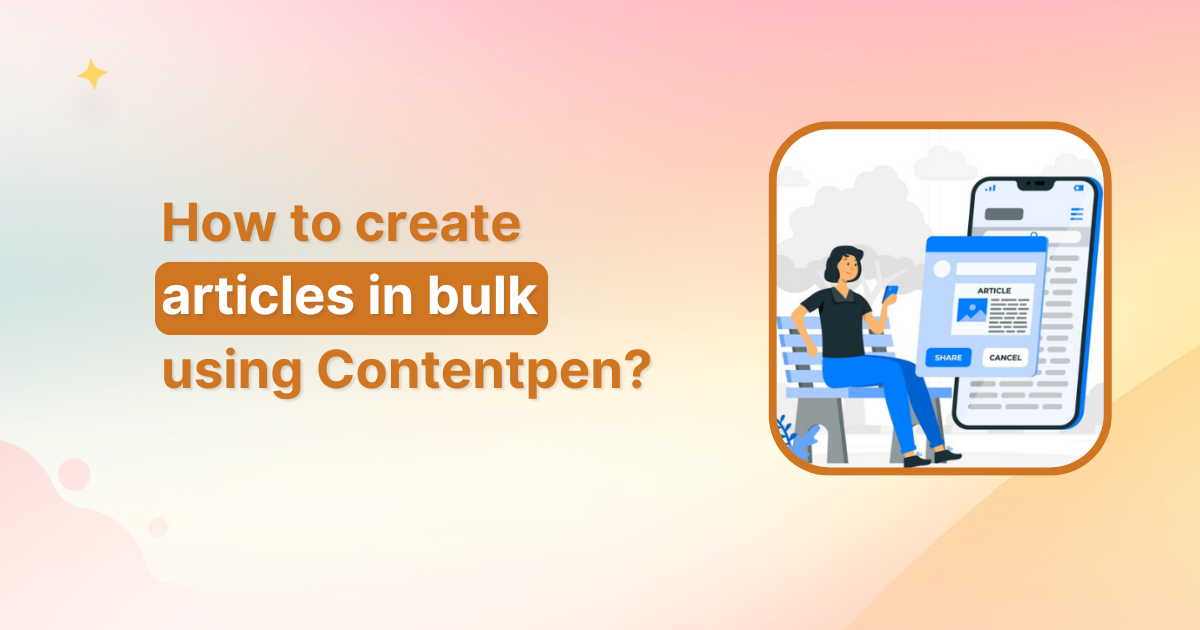How to automate internal and external linking using Contentpen

Effective internal and external linking is essential for SEO, guiding users through your website, and building content authority. Proper links help search engines understand your site structure and direct readers to related content. While manual linking works for smaller sites, it becomes time-consuming and error-prone as your content grows.
Automation streamlines this process by scanning your site and inserting valuable links without manual effort, saving time and ensuring consistency.
Wondering how much time manual linking costs you?
By the end of this guide, you’ll see why automating your linking strategy boosts SEO, improves crawlability, and enhances user engagement. Contentpen makes this process simple and scalable, whether you’re a small business owner, content manager, or SEO specialist.
Why automate internal and external linking?
Manual link management quickly becomes overwhelming as your content volume increases. When you handle links on a case-by-case basis, inconsistencies inevitably emerge, with some pages receiving too many links while others remain underlinked or completely disconnected. This uneven approach not only wastes precious time but also creates an imbalanced site structure that confuses both users and search engines.
Manual linking creates several challenges as your content grows:
- Time-consuming process that diverts resources from content creation
- Inconsistent implementation leading to unbalanced site structure
- Difficulty in maintaining links as content volume increases
- Higher risk of missed linking opportunities
- Challenges in identifying the most valuable linking connections
Automated linking eliminates these challenges by systematically scanning your entire website for linking opportunities and inserting connections based on predefined rules and contextual relevance. Small business owners can maintain a professional site structure without hiring additional staff, while marketing teams can ensure linking consistency across hundreds or thousands of pages with minimal effort.
| Manual linking | Automated linking with Contentpen |
| A slow process that needs constant attention. | Saves hours of work through intelligent automation |
| Inconsistent implementation across content | Ensures uniform linking strategy site-wide |
| Links often added based on convenience rather than strategy | Strategic link placement based on relevance and SEO value |
| Difficult to scale as content library grows | Effortlessly scales with expanding content libraries |
| Prone to human error and oversight | Systematically identifies all potential linking opportunities |
| Requires ongoing manual review to maintain | Self-maintains with minimal oversight required |
How much of your workweek currently goes toward manual link-building and maintenance tasks?
The benefits extend beyond mere time savings. Automated linking creates a balanced link profile that clearly signals site relevance and authority to search engines, driving improved search visibility and organic traffic.
It prevents common issues like broken links, orphaned pages, and thin content areas while strengthening your overall site architecture. For websites with extensive content libraries, automation transforms linking from an insurmountable task into a strategic advantage that consistently supports your SEO goals.
Getting started: Automating linking with Contentpen
Automating linking with Contentpen is simple and integrates easily into your content workflow:
Start by logging in to your Contentpen account. From the dashboard you’ll see a feature menu on teh left from there go to Knowledge> Website.
You’ll spot the “Add sitemap” and “Find Sitemap” option
Step 01: Add your sitemap
Upload your sitemap so Contentpen can understand your website’s internal structure.
Step 02: Filter internal links (Optional step)
Use Contentpen’s filtering options to exclude specific internal links you don’t want inserted. This helps you maintain control over your link strategy by avoiding redundant or low-priority pages.
Step 03: Manage your sitemaps
Once added, your sitemap(s) will appear with status indicators. You can test URLs or edit/remove entries as needed. Internal linking works based on these sitemaps – no keyword filtering or domain exclusions are needed for this step.
Step 04: Enable external linking (optional)
Turn on the external linking toggle if you want Contentpen to automatically insert relevant external links. It will find high-quality articles based on your niche and language preferences.
Pro tip: Specify which domains you want to include or exclude from external links. This keeps your content free from competitor links and ensures only trusted sources are used.
Step 05: Proceed to next step
Click Next to move forward and continue setting up the rest of your content optimization.
The benefits of automated linking for SEO and user experience
Implementing automated linking delivers substantial advantages for both your site’s search engine performance and visitor experience:
- Boosted search engine crawlability and indexing
- Strategic distribution of authority across your site
- Improved page rankings for key content
- Enhanced user navigation and engagement
- Reduced likelihood of orphaned pages
- Consistent implementation of your linking strategy
Boosting search engine crawlability and indexing
Automated internal linking creates clear pathways for search engine bots to discover and index every corner of your website. Pages that might otherwise remain isolated (commonly called “orphan pages”) become seamlessly integrated into your site’s structure through contextually relevant links.
When search engines can easily navigate your site, they’re more likely to discover, crawl, and index all your valuable content. This comprehensive linking network signals to Google and other search engines that your site is well-organized and thorough – qualities that positively influence your overall rankings.
Improved crawlability also means that updates and new content get picked up more quickly, keeping your site fresh and relevant in search results. Each automated internal link acts as a signpost, guiding both users and crawlers through your content ecosystem and ensuring that no valuable page gets overlooked or undervalued in search results.
Distributing authority and improving page rankings
Internal links distribute authority (sometimes called “link juice”) from high-performing pages to those that need a ranking boost. Automated linking systems ensure this distribution happens strategically and consistently across your entire website.
By identifying your cornerstone content and automatically linking it to related, less prominent pages, the system helps elevate the overall ranking potential of your site. This balanced flow of authority distribution enhances individual page rankings while supporting a cohesive site-wide SEO strategy that builds on your existing strengths.
Have you noticed certain pages on your site performing well while others struggle to gain visibility?
Automation minimizes human error in authority distribution and ensures important pages receive necessary attention at scale. With methodical link placement, every page benefits from the collective strength of your website, leading to noticeable improvements in search engine visibility and performance across your entire content library.
Enhancing user navigation and engagement
Well-placed internal links guide readers naturally through your content, directing them to related articles and valuable resources they might otherwise miss. This intuitive navigation encourages visitors to spend more time exploring your site, reducing bounce rates and increasing engagement metrics that search engines value.
Automated linking ensures every content piece connects logically to related topics, creating a seamless user journey that feels natural rather than forced. As visitors find it easier to locate relevant information, their overall experience improves significantly – they’re more likely to view multiple pages, return for future visits, and perceive your site as an authoritative resource.
The interconnected environment created through automated linking serves both functional and strategic purposes, making navigation intuitive while simultaneously strengthening your site’s topical authority in the eyes of search engines.
Conclusion
Automating internal and external linking is no longer a luxury – it’s essential for scaling content marketing. As content grows, manual linking becomes unmanageable and inconsistent, hurting SEO and user experience.
Contentpen is the AI blog writer tool that solves this with intelligent automation, offering sitemap integration, contextual link suggestions, and customizable presets to keep your site structure strategic and user-friendly.
With Contentpen, you get better crawlability, improved authority flow, and smoother user journeys – without the manual effort.
It lets you focus on creating valuable content while ensuring every page is meaningfully connected. As search engines prioritize relevance and experience, automated linking gives you a lasting edge.
Frequently asked questions
Internal linking helps search engines understand your website structure and distribute link equity across your pages. It also guides users to related content, increasing time on site and improving engagement metrics that support better rankings.
Contentpen uses your website’s sitemap to identify related pages and automatically inserts contextually relevant internal links. This ensures comprehensive coverage and consistent implementation across all content without manual effort.
Contentpen scans your content for relevant topics and context, then recommends authoritative external sources that match your content’s theme. It also allows you to block competitor domains to avoid linking to unwanted sources.
No. Contentpen is designed to preserve the natural reading flow. It places links contextually and intelligently, ensuring that the reader experience remains seamless and engaging.
Contentpen scans your entire site, including existing pages, and inserts links based on contextual relevance and sitemap structure. This ensures older content also benefits from updated and strategic linking.
Contentpen is ideal for content marketers, SEO professionals, editors, and website owners who manage growing content libraries and want to scale their linking strategy without sacrificing quality or consistency.
You might be interested in...

How to find high opportunity keywords in Contentpen?
If you’re creating content that ranks, converts, and stands out, finding the right keywords is half the battle. In Contentpen, spotting high opportunity keywords, those with good traffic potential and low competition, is a breeze if you know where to look. Here’s a step-by-step guide to help you uncover keywords that bring results. Step 01: […]
Jul 10, 2025

How to create articles in bulk using Contentpen?
Writing articles one by one can slow you down, especially if you’re managing multiple content projects, clients, or websites. That’s where Contentpen’s bulk article generation feature comes in. It allows you to create dozens of articles using presets and keywords in just a few clicks, saving you hours of manual work. Whether you’re building a […]
Jun 30, 2025

How to refresh an existing article in Contentpen?
Content doesn’t just need to be created, it needs to stay relevant, accurate, and engaging. That’s why Contentpen’s article refresh feature is a game-changer for bloggers, marketers, and SEO professionals alike. Whether you’re updating outdated stats, improving SEO, or giving your piece a modern twist, Contentpen makes refreshing articles quick and simple. In this guide, […]
May 29, 2025